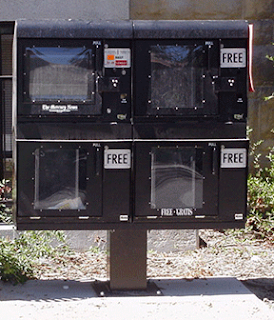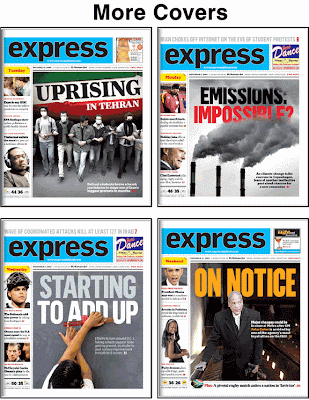 A reader of this blog asked me if I had any ideas on how to improve his circulation. I told him to stop smoking and take a brisk walk every morning.
A reader of this blog asked me if I had any ideas on how to improve his circulation. I told him to stop smoking and take a brisk walk every morning.As for the delivery of newspapers, I wish I had a cute one-liner. Transportation and delivery logistics are one of the most difficult challenges facing any free daily newspaper. No matter how strong your news coverage is, no matter how aggressive your ad reps are, you can't succeed unless you deliver the product to readers. And, sad to say, ads in online editions just don't bring in the dollars you can get through print advertising.
The following is my attempt to bring together the best ideas I've heard regarding distribution. Very few of them are original, but I'm not sure if those who offered their ideas wanted their names associated with them or not, so I won't attribute my sources. Here goes.
- 1. For free papers, news racks are essential. If you can't buy new racks, get used ones. Calls to landfill managers and recycling plants can be helpful -- let them know that if they ever see any old racks they should give you a call. Sometimes all an old rack needs is a good paint job. And remember, you don't need the coin mechanism if you're free, so rip it out before you put the rack on the streets.

- 2. Avoid throwing a bundle of papers at the front door of a restaurant or retailer who is supposed to display your papers. Sure, some employees of these businesses might figure out that they should place your papers inside where customers can grab them. But many businesses have a lot of turnover, and the next employee might regard your bundle as trash. Instead, when the business opens, you might have a delivery person return to place the papers inside.
3. If possible, hire a daytime delivery person or persons to walk a downtown district. This person's job might not be so much a delivery job as much as a job to make sure that papers delivered earlier got to the right distribution points. This person could also help with the paper's public relations by listening to businesses who have complaints about delivery and establishing new distribution points. I think it was the San Mateo (California) Daily Journal who called these people "ambassadors" -- a good title.
4. Know your news rack ordinances. Most cities put them online. Look for the municipal code on the city's website. If it's not there, go to the city's Planning Department or Code Enforcement office and ask for a copy.
5. City officials don't like complaints from residents or businesses. Keep this in mind when you're placing a new rack. Even if the rack is perfectly legal under the code, if it becomes controversial, you'll have to move it -- or get into a time-consuming fight.

- 6. In many cities, competing newspapers work together to install modular racks for several papers. If you're not aware of this practice, call your competitors and ask. You'll have to pay your share for rack units and installation, but you don't want to be left out of the next modular unit that's installed.
7. Avoid inserts. Inserts tend to fall out of a stack of papers and make a mess on the floor. If you're distributing inside a business, the mess might jeopardize your ability to distribute there in the future.
8. Check on delivery people. Make time to personally check routes. With a free paper, it's too easy for a delivery person to dump their papers in the trash and skip the route. Develop a list of business people you can call to ask if your papers were delivered to their establishments. Include a note in your paper that asks readers to call if they can't find today's paper. This will help you determine which stops need more papers in the future.
9. Eliminate stops where only one or two papers are delivered. The more stops where you can deliver large quantities, the faster a route can be done. Remember, newspapers are a mass medium.
10. Aim to complete deliveries by automobile before rush hour. Once people start crowding the roads on their way to work, delivery becomes much harder, and the productivity of your drivers declines greatly. If you need more time to deliver, negotiate an earlier deadline with your newsroom. Is your paper so time-sensitive that the current deadline is essential? What's more important -- getting that last West Coast score into your sports section, or delivering thousands more papers before deadline?




 Robinson (left) helped free daily pioneer Jim Pavelich start the Summit Daily News in August 1989. He went on to the short-lived Ventura (California) Today. Later he was editor of the Aspen (Colorado) Daily News. Then he helped to start an independent Sunday-only paper in the valley that includes Aspen.
Robinson (left) helped free daily pioneer Jim Pavelich start the Summit Daily News in August 1989. He went on to the short-lived Ventura (California) Today. Later he was editor of the Aspen (Colorado) Daily News. Then he helped to start an independent Sunday-only paper in the valley that includes Aspen. The Portland Daily Sun began in February 2009 and has a daily circulation of 14,000. It publishes Tuesday through Saturday. Robinson is partners with Adam Hirsham and Mark Guerringue of the Conway Daily Sun, a free daily community paper that has operated since 1989. The Conway paper's press prints the Portland paper. Hirsham and Guerringue are investors in free dailies in Berlin, N.H., and Livonia, N.H. Those papers also have the word "sun" in their name, suggesting the sun is rising all over New England.
The Portland Daily Sun began in February 2009 and has a daily circulation of 14,000. It publishes Tuesday through Saturday. Robinson is partners with Adam Hirsham and Mark Guerringue of the Conway Daily Sun, a free daily community paper that has operated since 1989. The Conway paper's press prints the Portland paper. Hirsham and Guerringue are investors in free dailies in Berlin, N.H., and Livonia, N.H. Those papers also have the word "sun" in their name, suggesting the sun is rising all over New England. A controversy has erupted in Colorado over a free daily's firing of a reporter who criticized Vail Resorts for exaggerating snowfall reports.
A controversy has erupted in Colorado over a free daily's firing of a reporter who criticized Vail Resorts for exaggerating snowfall reports. The Summit Daily News, based in the ski town of Breckenridge (above), gets a lot of its advertising from Vail Resorts, the owner of ski-lifts and real estate offices in that town as well as Vail.
The Summit Daily News, based in the ski town of Breckenridge (above), gets a lot of its advertising from Vail Resorts, the owner of ski-lifts and real estate offices in that town as well as Vail. The Washington Post has redesigned its free daily,
The Washington Post has redesigned its free daily,  Instead, Express now has a cover story each day consisting of a headline and large photo — but no text. Inside Express is devoting a full-page to the cover story, giving a writer an opportunity to go into more depth than usual.
Instead, Express now has a cover story each day consisting of a headline and large photo — but no text. Inside Express is devoting a full-page to the cover story, giving a writer an opportunity to go into more depth than usual. • Dec. 1: "Obama's War," a preview of his national TV speech on increasing troop levels in Afghanistan.
• Dec. 1: "Obama's War," a preview of his national TV speech on increasing troop levels in Afghanistan. "Our goal is to pack more news onto our pages than ever before while at the same time making the paper more attractive and easier to navigate," said a front page note introducing the redesign on Nov. 30.
"Our goal is to pack more news onto our pages than ever before while at the same time making the paper more attractive and easier to navigate," said a front page note introducing the redesign on Nov. 30. Randy Miller — the owner of a free daily in Telluride, Colo., and a weekly in Tucson, Ariz. — has reached an agreement to buy the free daily East Valley Tribune in Mesa, Ariz., rescuing it from closure.
Randy Miller — the owner of a free daily in Telluride, Colo., and a weekly in Tucson, Ariz. — has reached an agreement to buy the free daily East Valley Tribune in Mesa, Ariz., rescuing it from closure. The bad news ... The experiment of converting the Mesa (Ariz.) Tribune from paid to free circulation has failed. The owners, Freedom Communications, have announced the paper will close Dec. 30 unless a buyer is found. That will result in the layoff about 140 employees.
The bad news ... The experiment of converting the Mesa (Ariz.) Tribune from paid to free circulation has failed. The owners, Freedom Communications, have announced the paper will close Dec. 30 unless a buyer is found. That will result in the layoff about 140 employees. Metro in NY, Philly and Boston will unveil a redesign on Monday that a press release says will help the free daily in "targeting the hard-to-reach metropolitan." The big changes we see on the front are:
Metro in NY, Philly and Boston will unveil a redesign on Monday that a press release says will help the free daily in "targeting the hard-to-reach metropolitan." The big changes we see on the front are: Newsboys and girls, dressed in poorboy caps and white oxford shirts yelling "Extra! Extra!," handed out copies of Toronto's newest daily, t.o.night, to people on the streets of Canada's most populous city yesterday afternoon.
Newsboys and girls, dressed in poorboy caps and white oxford shirts yelling "Extra! Extra!," handed out copies of Toronto's newest daily, t.o.night, to people on the streets of Canada's most populous city yesterday afternoon.